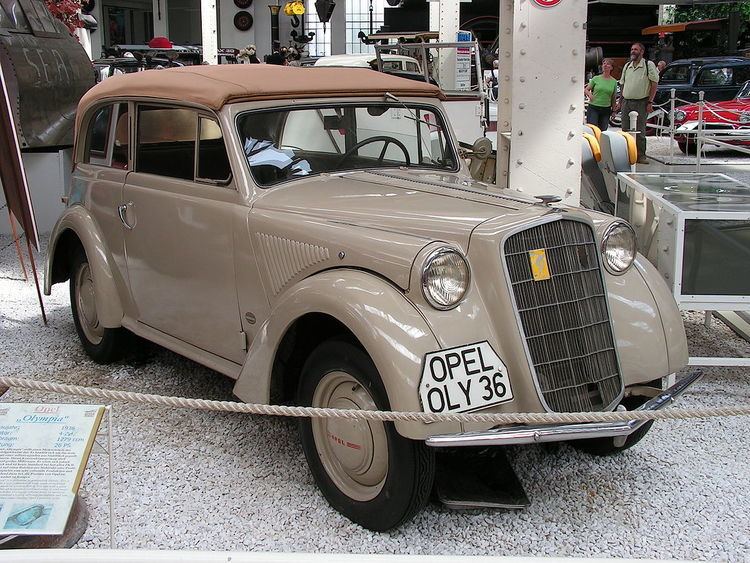Predecessor Opel 1.3 litre | Production 1935–1970 | |
 | ||
Successor | ||
The Opel Olympia is a compact car produced by the German automaker Opel from 1935 to 1940, from 1947 to 1953 and again from 1967 to 1970.
Contents
- Opel Olympia 19351937
- Opel Olympia OL38 19371940 19471949
- Opel Olympia 1950 19501953
- First successors Opel Olympia Rekord 195357 later Opel Rekord 195786
- Name revival Opel Olympia A 19671970
- References
The 1935 Olympia was Germany's first mass-produced car with an all-steel unitized body (monocoque). This revolutionary technology reduced the weight of the car by 180 kilograms (400 lb.) compared to its predecessor. Production of the unibody design required new production methods and materials. Spot welding, advanced types of steel, and a new production line layout were among the many advances introduced by the Olympia.
The car was first presented in February at the 1935 Berlin Motor Show; production got under way later during that year. The Olympia was named in anticipation of the 1936 Berlin Olympic Games. Before World War II it was made in two versions. From 1935 to 1937 the Olympia had a 1.3-litre engine. For the OL38 version made from 1937 to 1940 this was replaced by a 1.5-litre overhead valve unit.
Between 1935 and the 1940 over 168,000 units were built.
The name Olympia was revived in 1967 for a luxury version of the Opel Kadett B.
Opel Olympia (1935–1937)
At 2500 Reichsmark it offered a true four-seater with 1.3-litre, 4-cylinder, side-valve, 24 hp (18 kW) engine capable of 100 km/h (62 mph). Drive was to the rear wheels through a three speed gearbox but a four speed unit became available in 1937. The car had independent front suspension with a live axle at the rear and semi-elliptic leaf springs.
The car was made available in two versions, as a two-door saloon and as a two-door soft-top convertible:
Opel Olympia OL38 (1937–1940) (1947–1949)
A new engine was introduced in 1937 with a capacity of 1488 cc and overhead valves. It produced 37 hp (27 kW) and the top speed of the car was 112 km/h (70 mph). The car's body received a facelift.
It was available in the same versions as its predecessor with the addition of the 6-light LV:
Due to World War II, production came to a halt in late 1940. During the war, the Opel plant in Rüsselsheim was severely damaged by allied bomb attacks. After reconstruction, production of the Olympia restarted in late 1947. The OL 38 was unchanged to the pre-war car but only the two door sedan was produced. Until the end of 1949, 25.952 of them were made.
Opel Olympia 1950 (1950–1953)
In January 1950, the Olympia got a modernized body. But the car was still based on the pre-war Olympia. The following bodies were offered:
In three years of production, about 160,000 cars were made.
First successors: Opel Olympia Rekord (1953–57), later Opel Rekord (1957–86)
In March 1953, the 18-year-old design of the Olympia was finally replaced by a completely new car, the Opel Olympia Rekord, with a modern pontoon body.
Name revival: Opel Olympia A (1967–1970)
The Olympia name was revived in 1967. This time it was only a luxury version of the contemporary Opel Kadett B. Interior finishings were of a higher order than in the Kadett. Engines were an 1100 cc unit with 60 hp (44 kW) taken from the Kadett and two larger units, a 1700 cc with 75 hp (55 KW) and a 1900 cc with 90 hp (66 kW) which were normally used in the Opel Rekord. The bodywork was of the "fastback" style, rather than of the more upright regular sedan-style bodywork used on most Kadetts.
Body styles were:
The Olympia A was not highly successful, and was replaced in 1970 by the all new Opel Ascona.
